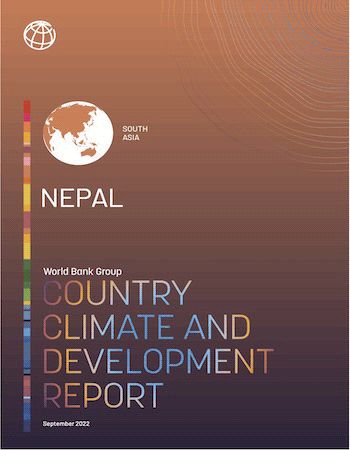As temperatures rise across South Asia, climate and disaster risks in Nepal are expected to increase further, affecting people, the economy, the environment, and development gains. Nepal’s temperature is projected to increase by about 0.9 C between 2016 and 2045 under a medium-range emissions pathway. Winters are projected to be drier and monsoon summers wetter, with up to a threefold increase in rainfall. The number of people in Nepal annually affected by river flooding caused by climate change could double to around 350,000 in 2030 (from 157,000 in 2010).
While Nepal has low per capita emissions and is a negligible contributor to global climate change, agricultural and energy-related emissions are also a key source of air pollution, with major negative economic implications. Emissions come primarily from agriculture (54 percent) and energy (28 percent. Between 2012 and 2019, Nepal’s emissions increased by 26.9 percent, primarily due to growing energy consumption in energy and industry, which accounted for 28.3 percent and 7.4 percent of Nepal’s GHG emissions in 2019. Biomass, transport, open burning, and industrial activities also contribute significantly to air pollution, with sizeable negative impacts on health and productivity.
Climate variability is impacting the Nepali economy through lower agricultural productivity, road damage, and high energy imports during the dry season, among other impacts. Floods and landslides have been the most frequent hazards over the past 40 years; these events are expected to increase as climate change accelerates. While southern and urban municipalities are more likely to experience flooding and heat stress, northern regions are affected by increased erosion, landslides, water stress, and glacial lake overflow. The most vulnerable communities often live in the most extreme environments that are subject to climate impacts and lack social protection programs. Women, indigenous people, and other marginalized communities are disproportionately affected.
Nepal has begun to put in place the necessary policy framework, such as the 2019 National Climate Change Policy, the 2022 Solid Waste Management Policy, the 2022 Forest Regulation, and the 2022 Land Use Regulation. However, implementation of this reform agenda and prioritization of investments is incipient. Moreover, enhanced prioritization and efficiency of public expenditure are required to maximize climate and development benefits.
This Country Climate and Development Report outlines four priority system transitions that are fundamental to addressing the risks that climate change poses to Nepal while also providing opportunities for improving the quality and sustainability of economic development: (a) improving systemic resilience of rural landscapes including food, freshwater, and forest systems to boost adaptation, livelihoods, and food security; (b) harnessing Nepal’s significant hydropower opportunities; (c) managing urbanization and environmental quality to build resilience and improve health; and (d) strengthening Nepal’s low-carbon, resilient connectivity — particularly roads — to improve the country’s growth and services. This report also outlines three key enabling themes to help support the priority system transitions toward a greener future for Nepal: strengthening the resilience of people and community assets through early warning systems, shock-responsive safety nets, and access to quality skills training; embedding disaster risk management at all tiers of government and across all sectors; and prioritizing Nepal’s funding needs by convening and coordinating financing for climate action.
Download
